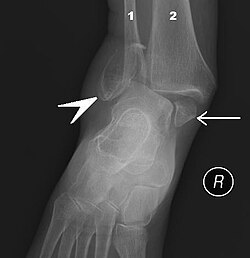Ankle fracture
(Redirected from Triplane Fracture)
Editor-In-Chief: Prab R Tumpati, MD
Obesity, Sleep & Internal medicine
Founder, WikiMD Wellnesspedia &
W8MD medical weight loss NYC and sleep center NYC
| Ankle fracture | |
|---|---|

| |
| Synonyms | Broken ankle |
| Pronounce | N/A |
| Specialty | N/A |
| Symptoms | Pain, swelling, bruising, inability to bear weight |
| Complications | Compartment syndrome, arthritis, infection |
| Onset | Sudden |
| Duration | Weeks to months |
| Types | N/A |
| Causes | Trauma |
| Risks | Osteoporosis, high-impact sports, falls |
| Diagnosis | Physical examination, X-ray, CT scan |
| Differential diagnosis | Ankle sprain, Achilles tendon rupture |
| Prevention | N/A |
| Treatment | Rest, ice, compression, elevation, casting, surgery |
| Medication | Pain relievers |
| Prognosis | Good with treatment |
| Frequency | Common |
| Deaths | N/A |
An ankle fracture is a break in one or more of the bones that make up the ankle joint. The ankle joint is composed of three bones: the tibia, the fibula, and the talus. Ankle fractures can range from a simple break in one bone, which may not prevent you from walking, to several fractures, which may force your ankle out of place and require you not to put weight on it for a few months.
Types of Ankle Fractures
There are several types of ankle fractures, and they are usually classified by the area of the bone that is damaged. These include:
- Lateral malleolus fracture: A fracture to the fibula bone in the lower leg.
- Medial malleolus fracture: A fracture to the tibia at the inside of the lower leg.
- Posterior malleolus fracture: A fracture to the tibia at the back of the lower leg.
- Bimalleolar fractures: Fractures that occur in both the tibia and fibula.
- Trimalleolar fractures: Fractures that occur in all three malleoli of the ankle.
Causes
Ankle fractures can occur from excessive rolling or twisting of the ankle, falls, or impact from accidents. High-impact sports such as soccer, football, and skiing are common causes of ankle fractures.
Symptoms
Symptoms of an ankle fracture can include pain, swelling, bruising, inability to walk or bear weight on the ankle, and deformity if the ankle is dislocated as well.
Diagnosis
Diagnosis of an ankle fracture usually involves a physical examination, an x-ray, and sometimes a CT scan or MRI to provide more detailed images of the injury.
Treatment
Treatment for an ankle fracture depends on the severity of the fracture. Non-surgical treatments include casting or splinting to immobilize the ankle and allow the fracture to heal. Surgical treatments may be necessary for more severe fractures and can involve the use of plates and screws to hold the bones in place while they heal.
Recovery
Recovery from an ankle fracture can take several weeks to several months and often involves physical therapy to restore strength and mobility to the ankle.
See Also
Transform your life with W8MD's budget GLP-1 injections from $125.
W8MD offers a medical weight loss program to lose weight in Philadelphia. Our physician-supervised medical weight loss provides:
- Most insurances accepted or discounted self-pay rates. We will obtain insurance prior authorizations if needed.
- Generic GLP1 weight loss injections from $125 for the starting dose.
- Also offer prescription weight loss medications including Phentermine, Qsymia, Diethylpropion, Contrave etc.
NYC weight loss doctor appointments
Start your NYC weight loss journey today at our NYC medical weight loss and Philadelphia medical weight loss clinics.
- Call 718-946-5500 to lose weight in NYC or for medical weight loss in Philadelphia 215-676-2334.
- Tags:NYC medical weight loss, Philadelphia lose weight Zepbound NYC, Budget GLP1 weight loss injections, Wegovy Philadelphia, Wegovy NYC, Philadelphia medical weight loss, Brookly weight loss and Wegovy NYC
|
WikiMD's Wellness Encyclopedia |
| Let Food Be Thy Medicine Medicine Thy Food - Hippocrates |
Medical Disclaimer: WikiMD is not a substitute for professional medical advice. The information on WikiMD is provided as an information resource only, may be incorrect, outdated or misleading, and is not to be used or relied on for any diagnostic or treatment purposes. Please consult your health care provider before making any healthcare decisions or for guidance about a specific medical condition. WikiMD expressly disclaims responsibility, and shall have no liability, for any damages, loss, injury, or liability whatsoever suffered as a result of your reliance on the information contained in this site. By visiting this site you agree to the foregoing terms and conditions, which may from time to time be changed or supplemented by WikiMD. If you do not agree to the foregoing terms and conditions, you should not enter or use this site. See full disclaimer.
Credits:Most images are courtesy of Wikimedia commons, and templates, categories Wikipedia, licensed under CC BY SA or similar.
Contributors: Prab R. Tumpati, MD



